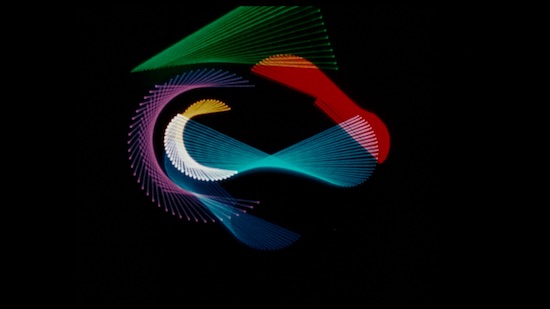David O’Reilly: The End of Stories. © David O’Reilly
The Zeiss-Großplanetarium is a shiny silver dome, seventy-five feet in diameter, equipped with a fancy projector. It was one of the last prestigious new builds in the former DDR. There’s an unsurprising whiff of Ostalgie about the joint, a now-misplaced optimism, and it features models of Soyuz rockets, images of Mars. Seats in the main hall flip back to give you an IMAX-like experience; people whose age is in double digits are likely to contain their excitement. The idea behind the current show is simple enough: how might a planetarium work as an art space? So that means a call-up for those occupied in interdisciplinary arts and crafts.
The press preview featured four works but there are many more in the programme: I’ll come back to that fact later. The show begins with John Whitney’s MN:P (1995), a late piece by the computer graphics whiz. Said to be inspired by Native-American peoples the work features abstract animations darting about the inner surface of the dome in time to what sounds like the clunky chords from an amplified toy piano. Arrows and bars zap from north to south, east to west. The reds and blues and yellows of the markings have an unappealingly faded look. As an opener for an event where one hoped to catch a glimpse of something forward-looking MN:P is something of a throwback. The shapes dashing about are reminiscent of those found in Viking Eggeling’s experiments with lines and curves from his monochrome Symphonie diagonale that dates from as far back as 1923.
Bill Ham and Emi Ito’s Light Painting #1 (2021) is accompanied by music by Kara-Lis Coverdale. Ham is another veteran, this time of multi-projection freak-outs. He did light shows in the San Francisco of the mid-1960s for the likes of the Grateful Dead and Quicksilver Messenger Service. What sounds like a viola drones away as a slow explosion of copper-blue coloured blobs drift around aimlessly. Again we’re zapped back to what was once the future. We’re in early VelvetsLand only this time without Gerard Malanga and his whip. You stare up into a rippling pool in the sky and watch a set of multi-coloured stains diffuse above your head. It’s like being trapped in a lava lamp. Better yet, imagine being slowly suffocated by a washed-out, tie-dyed duvet. Taking acid beforehand might have helped make the experience more tolerable.
Aporia (2021) by Patricia Detmering gives us humanoid figures wandering around an artificial world. Groups form and disperse randomly according to artificial intelligence algorithms. We’re told Elias Canetti’s book Crowds and Power (1960) is a significant influence on the work but I was more reminded of a 1985 advert for the Royal Bank Of Scotland. Giacometti-inspired prancing pipe-cleaner men were seen doing deals; Detmering’s figures have a similar stride. Canetti argued that The Crowd needs a direction. From where I was sitting, the masses at the Planetarium might agree: the unenthusiastic audience sensed a lack of focus; applause was thin and desultory.
Thomas Wilfred’s Opus 79 Multidimensional (1932) is unaccompanied by music. Essentially what we see is a foggy set of shifting, slowly drifting shafts of colour, predominantly in red and orange. Watching this in darkness for over ten minutes is discombobulating; the brain tries to find a focal point but can’t. The initial novelty – am I looking at clouds above Mars? – wears off pretty quickly and a restless boredom sets in. As time goes on the effect becomes frightening. You think of retinal haemorrhage. You think of blindness and the fear that this limitation of vision could go on forever: a real infinity.

John Whitney: Homage to Rameau © John Whitney 1967, Whitney Editions™, Los Angeles CA
Blessed relief comes with Actress and Actual Objects Grey Interiors (2021). Darren J. Cunningham’s composition is up to his usual high standard. The music has a wonky, melancholic wooziness that matches the disorientating visuals. We see weightless machine parts drift around in slow motion. Like an animated series of photograms (images of objects made by placing them directly onto photographic paper), Grey Interiors recalls the experiments of Maholy-Nagy and Man Ray. More recently, Thomas Ruff has made computer-generated updates on the idea. There’s an infinity of choice for artists when they use algorithms and computer-generated effects but Actress and the artist’s collective Actual Objects have the discipline to lasso the possibilities and give us, easily, the most solid, the most effective and affective work in the entire press preview.
I mention the preview again because in order to see the large number of other works you have to pay eight euros to catch a group of three videos, a set that lasts approximately half an hour. The shows are spread over several days and at widely dispersed times of the day, i.e., they are not shown on a loop. There was only one ‘marathon’ showing and even that didn’t contain the whole set of presentations. Annoyingly there are some other fantastic artists here such as Agnieszka Polska, Emeka Ogboh, and Robert Lippok (working with Lucas Gutierrez) who I missed. To see all the works you’re talking about hanging around the Planetarium twiddling your thumbs for a near-infinity of hours between shows. And you’ll need more than fifty euros too. Given the current vicissitudes of fortune – PCR testing costs, gas and electricity and rental hikes here in Berlin und so weiter – you could say the organisers have imagined another New Infinity: pockets deeper than deep space.


